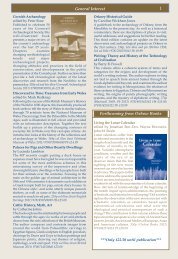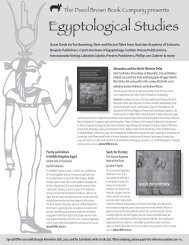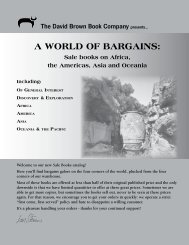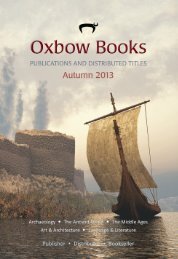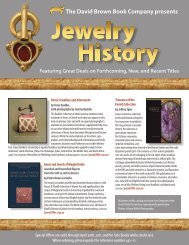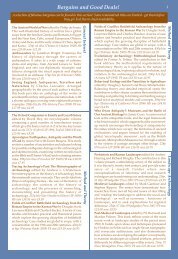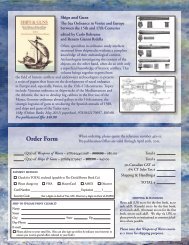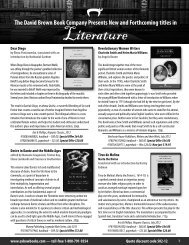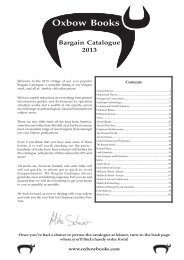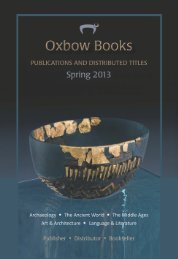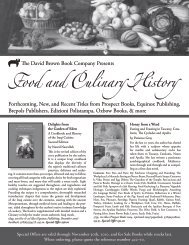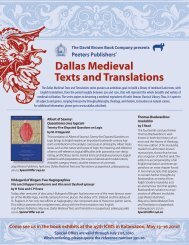New Distributed Titles Fall 2009 - Oxbow Books
New Distributed Titles Fall 2009 - Oxbow Books
New Distributed Titles Fall 2009 - Oxbow Books
Create successful ePaper yourself
Turn your PDF publications into a flip-book with our unique Google optimized e-Paper software.
Hooked-Clasps and Eyes<br />
A Classification and Catalogue<br />
of Sharp- or Blunt-Hooked Clasps and<br />
Miscellaneous Hooks, Eyes, Loops, Rings and Toggles<br />
by Brian Read<br />
A never-before-attempted classification – a must for archaeologists,<br />
museum curators, dress historians and anyone involved<br />
with historical reenactment. Periods covered: Roman, early medieval,<br />
late medieval and early post-medieval. Foreword by Geoff<br />
Egan of the Museum of London.<br />
251p, 874 col and b/w illus, paperback, 9780953245055, $39.95,<br />
Portcullis Publishing, December 2008.<br />
medieval studies<br />
Medieval Garments Reconstructed<br />
Norse Clothing Patterns<br />
by Else Ostergård, Anna Norgård and Lilli Fransen<br />
This volume begins with a short introduction by Else Ostergård to the amazing finds of garments from the Norse settlement of Herjolfnes in Greenland.<br />
It then features chapters on technique – production of the thread, dyeing, weaving techniques, cutting and sewing – by Anna Norgård. Also included<br />
are measurements and drawings of garments, hoods, and stockings, with sewing instructions, by Lilli Fransen. A practical guide to making your own<br />
medieval Norse garment!<br />
200p, illus, hardback, 9788779342989, $30.00, Aarhus University Press, December <strong>2009</strong>.<br />
Metal Buttons<br />
c. 900 BC – c. AD 1700<br />
by Brian Read<br />
Portcullis Publishing – <strong>New</strong>ly distributed by DBBC!<br />
First North American<br />
distribution<br />
This book differs from most other publications on buttons, in<br />
that examples of metal button-like objects and buttons dating<br />
between c. 900 BC – c. AD 1700 are subjected to a detailed<br />
manufactory analysis, each being described both textually and<br />
illustratively. Although not foolproof, this information is essential<br />
for the dress historian, button collector, archaeologist, museum<br />
curator, dealer, or anyone with an interest, seeking to gauge the<br />
age of any particular button.<br />
121p, col & b/w illus, paperback, 9780953245048, $30.00, Portcullis Publishing, December 2005.<br />
Oreficerie toscane medioevali e rinascimentali nella collezione Raspini<br />
by Chiara Sabbadini Sodi<br />
Presentation of two dozen sacred goldsmith’s works, including chalices, reliquaries and censers from<br />
the medieval and Renaissance collection of Giovanni Raspini. Each object is individually presented, with<br />
information on its origins, chronology, size and provenance, along with a bibliography and indications<br />
on history, use and conservation. Italian text.<br />
72p, col illus, hardback, 9788859605539, $46.00(s), Edizioni Polistampa, November <strong>2009</strong>.<br />
Things from the Town<br />
Artefacts and Inhabitants<br />
in Viking-age Kaupang<br />
edited by Dagfinn Skre<br />
In this third volume deriving from the 2000-2003 excavations<br />
of the Viking town of Kaupang, a range of artifacts is presented<br />
along with a discussion of the town’s inhabitants: their origins,<br />
activities and trading connections. The main categories of<br />
artifact are metal jewelry and ornaments, gemstones, vessel<br />
glass, pottery, finds of soapstone, whetstones, and textileproduction<br />
equipment. The artifacts are described and dated,<br />
and their areas of origin discussed. The volume is lavishly<br />
illustrated.<br />
420p, illus, hardback, 9788779343092, $75.00, Aarhus<br />
University Press, November <strong>2009</strong>, Kaupang Excavation Project 3.<br />
The Medieval Broadcloth<br />
Changing Trends in Fashions,<br />
Manufacturing and Consumption<br />
edited by Kathrine Vestergård Pedersen<br />
and Marie-Louise B Nosch<br />
The eight papers presented here provide a useful introduction<br />
to medieval broadcloth, and an up-to-date synthesis of current<br />
research. The word broadcloth is nowadays used as an overall<br />
term for the woven textiles mass-produced and exported all<br />
over Europe. It was first produced in Flanders as a luxurious<br />
cloth from the 11th century and throughout the medieval period.<br />
Broadcloth is the English term; it is Laken in Flemish, Tuch<br />
in German, Drap in French, Klæde in the Scandinavian languages,<br />
and Verka in Finnish. As the concept of broadcloth has<br />
derived from written sources, it cannot directly be identified in<br />
the archaeological textiles and therefore the topic of medieval<br />
broadcloth is very suitable as an interdisciplinary theme.<br />
160p, b/w illus, 24p of col pls, paperback, 9781842173817,<br />
$50.00, <strong>Oxbow</strong> <strong>Books</strong>, December <strong>2009</strong>, Ancient Textiles Series 6.<br />
www.dbbconline.com 45




